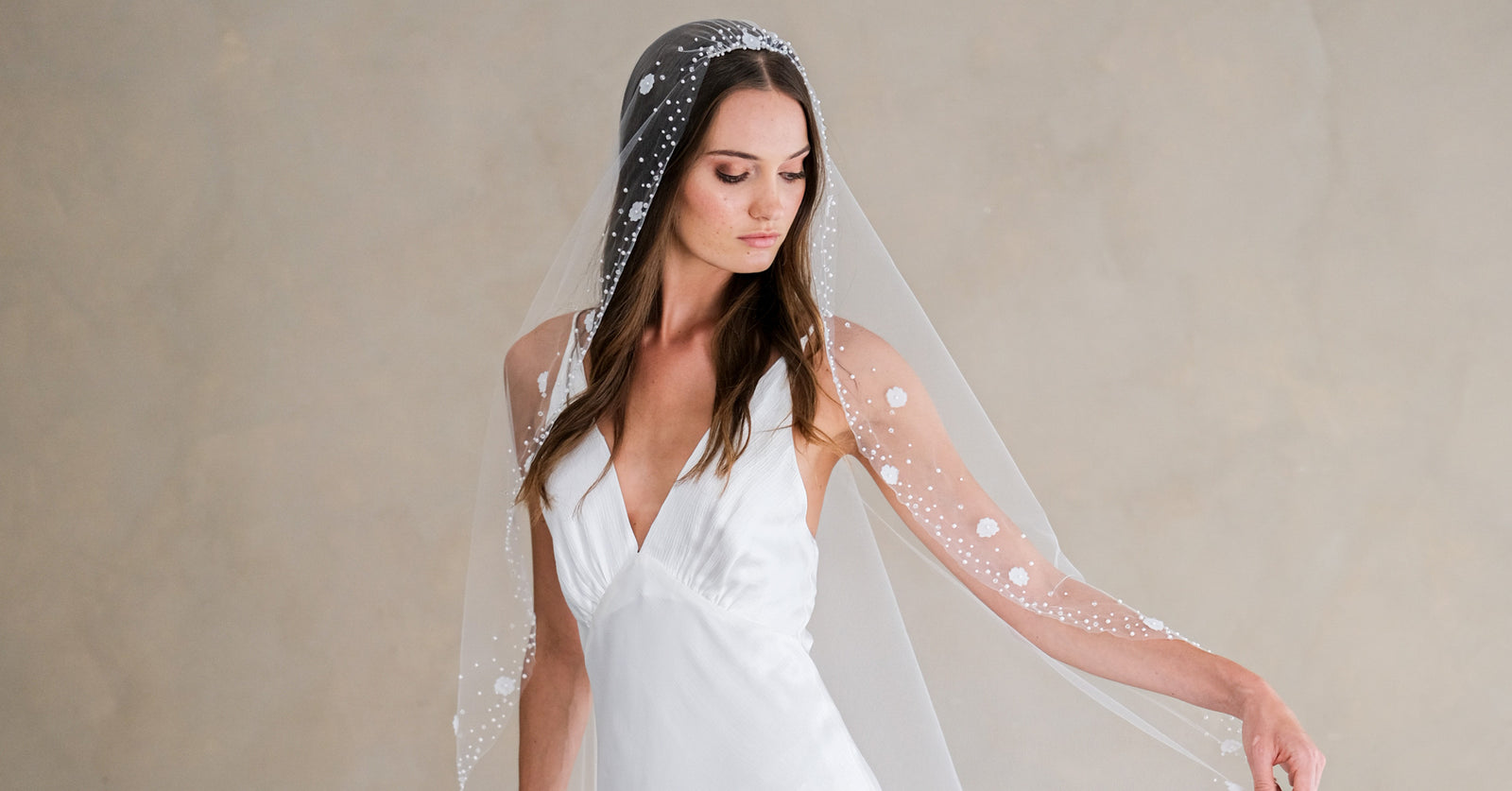Your Cart is Empty
FREE SHIPPING ON ORDERS OVER $250

If you’re a regular on our blog page, you may be all too familiar with the origins of the bridal veil. To sum it up, it protects brides from evil spirits and preserves their virginity until the big unveiling (no pun intended) and kiss. Interpretations may differ across religions, but this is the most widely accepted one.
However, until now, we haven’t delved deep enough into the story of how lace and pearl veils came to be. Why is it called a veil? When was it first used? What was it initially used for? And what wedding superstitions did people at the time believe about wearing one? It’s time we take our veil expertise into overdrive to satiate your burning curiosity.
Before the Word ‘Veil’
It’s worth noting that the term ‘veil’ is a relatively modern concept, with the first recorded mention being sometime during the 13th century. The Oxford English Dictionary credits it to the Ancrene Riwie(also known as the Ancrene Wisse), a guide for anchorites or women who opt to lead a secluded life in favour of fervent prayer.
Before that, a wedding veil went by many names. First, there’s the Roman flammeum, called such due to its flame-coloured hue (flammeum means ‘flame-coloured’) and how the way it covered women from head to toe was akin to being on fire. Of course, it left their faces uncovered.
Far earlier than the flammeum is ancient Greece's kalyptra, which is its term for ‘veil.’ Female aristocrats wore this covering as a sign of affluence and a means of protection from men attempting sexual advances toward them.
Between the Roman Empire’s eventual adoption of Christianity in the late fourth century CE and the intermixing of cultures, veils soon became a staple of women’s church wear. However, the colour changed to suit the religion’s needs to purple or white, leading to the flammeum falling out of favour after the fifth century CE (though later veils were still called flammeum for a time).
Veils in the old days weren’t limited to weddings, especially in Christianity. Historians often cite two grounds for the strict requirement that women be veiled at all times.
The first is the image of the Virgin Mary wearing a veil, which often appears blue or white. White reflects her purity, modesty, and unconditional motherly love – a belief that holds to this day. On the other hand, blue wasn’t as common because dyeing fabric in such a hue was difficult at the time. It did cement her essential, if not divine, status in ancient society.
The second comes from the Bible, specifically the Apostle Paul’s letter to the Corinthians. We mentioned this in our previous blog post on lace wedding veils, but as the passage on the subject states, wearing a veil is preferable over cutting a woman’s hair short. Paul also referred to a veil as a symbol of authority.
For a man ought not to cover his head, since he is the image and glory of God, but woman is the glory of man. For man was not made from woman, but woman from man. Neither was man created for woman, but woman for man. That is why a wife ought to have a symbol of authority on her head, because of the angels.
The practice of women wearing veils in everyday life persisted for centuries until the 1980s when Canon 1262 was repealed. It’s unclear why the Vatican chose not to incorporate this tradition into the current 1983 Code of Canon Law. Some believe the practice was outdated (though it never said anything of the sort), but it wasn’t outlawed as some parishes still require it.
Only Bridal Veils Remained
 CORALIE I - One Tier Lace Mantilla Veil
CORALIE I - One Tier Lace Mantilla Veil
You’d be hard-pressed to find a church that still requires veils for women, even if only when going to church. However, veils still seem a must for brides at weddings (some have opted to go veilless). Why is that still the case?
One word: fashion.
While brides still wear bridal veils for cultural or religious reasons, those who have neither in mind do so because it looks good on them. It’s one of the legacies of Queen Victoria’s historic wedding to Prince Albert in 1840, which had the unintentional effect of redefining weddings past the Victorian era.
Industry leaders agree that the veil's role has shifted mainly from one of tradition to one of fashion. An accessory to the wedding dress, it hides the bride’s elegance behind a shroud that the groom later lifts or parts before the kiss, unveiling a breathtaking look during the wedding ceremony. Adding lace patterns or pearls serves to accentuate the bride’s look even further.
It makes sense for the bride to pull out all the stops to look stunning as she walks down the aisle. Most women only experience one wedding day throughout their lives, so it’s in their best interests to make this big day one worth remembering for ages.
The bridal veil is as rich in history as it is in interpretations. Whether or not you believe in wedding traditions, there’s no denying that it’s here to stay for generations of weddings.